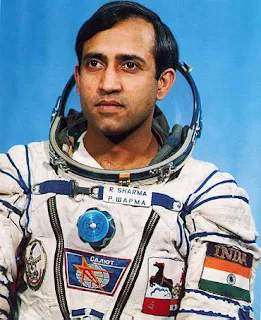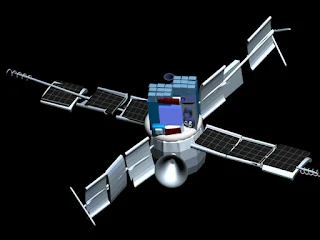 |
| 3D Picture of Space Travel of Astronaut By Me |
SPACE TRAVEL:
People have long wanted to journey beyond the earth, but it is only quite recently that space travel has become reality.In order to escape from the gravitational pull of the earth. The modern rocket has been developed .People began to investigate space by using rockets to shoot small objects, called artificial satellites, into orbit round the earth. The first one, Sputnik 1, was launched by the USSR in 1957. These complicated devices are used for various purposes: to obtain information about the sun, stars, and other things in the universe, to study weather patterns in the earth`s atmosphere, ot to act as communication and navigation devices.Telstar 1. A communications sarellite launched in 1962. made possible the first direct television link between Europe and America. Today Intelsat satellites send messages all over the world.
MANNED SPACE FLIGHT:
Indian Space Programme and Rakesh Sharma
Wing Commander Rakesh Sharma,(born January 13, 1949) is a former Indian Air Force test pilot, and Cosmonaut aboard Soyuz T-11 as part of an Intercosmos Research Team. Sharma was the first Indian to travel in space.
 |
| Rakesh Sharma |
Sharma joined the Indian Air Force and progressed rapidly through the ranks. Sharma, then a Squadron Leader and pilot with the Indian Air Force embarked on a historic mission in 1984 as part of a joint space program between the Indian Space Research Organisation and the Soviet Intercosmos space program, and spent eight days in space aboard the Salyut 7 space station. Launched along with two Soviet cosmonauts aboard Soyuz T-11 on the 3 April 1984, was 35-year-old Sharma. During the flight, Sharma conducted multi-spectral photography of northern India in anticipation of the construction of hydroelectric power stations in the Himalayas. In a famous conversation, he was asked by the then Prime Minister Indira Gandhi how India looked from space, to which he replied, ''Main binaa jhijhak ke keh sakta hoon.., Sare Jahan Se Achcha" (a reference to an iconic poem used in India's freedom struggle, usually referred to as 'Saare jahaan se achha Hindustan haamara, ' our land of Hindustan, is the Best in the world').
He was conferred with the honour of Hero of Soviet Union upon his return from space. The Government of India conferred its highest gallantry award (during peace time), the Ashoka Chakra on him and the other two Soviet members of his mission.
Non Residential Indian Astronaut:
 |
| Kalpana Chawla |
Kalpana Chawla (July 1, 1961 – February 1, 2003) was an Indian-American astronaut with NASA. She was one of seven crew members killed in the Space Shuttle Columbia disaster. Kalpana Chawla was born in Karnal, Haryana, India on July 1, 1961 to a Sindhi family named Banarasi Lal Chawla and Sanjyothi. She had 2 sisters, Sunita and Dipa, and a brother, Sanjay. She became a US citizen in 1990. She was the youngest of four siblings in the family. Chawla died in the Space Shuttle Columbia disaster which occurred on February 1, 2003, when the Space Shuttle disintegrated over Texas during re-entry into the Earth's atmosphere, with the loss of all seven crew members, shortly before it was scheduled to conclude its 28th mission, STS-107.
.jpg) |
| Sunita Williams |
Sunita Williams (born September 19, 1965) is a United States Naval officer and a NASA astronaut. She was assigned to the International Space Station as a member of Expedition 14 and then joined Expedition 15. She holds the record of the longest spaceflight (195 days) for female space travellers. Williams was born in Euclid, Ohio to Deepak Pandya and Bonnie Pandya, who reside in Falmouth, Massachusetts. Deepak Pandya is a famous neuroanatomist. Williams’ roots on her father’s side go back to Gujarat in India and she has been to India to visit her father’s family. She is of Slovenian descent from her mother’s side; therefore, she is Indian-Slovenian American
 |
| Yuri Gararin: Russian Astronaut First Man In Space |
In 1962, the first manned space flight was made by Soviet cosmonaut Yuri Gagarin.He made one orbit of the earth. John Glenn wa the first American to be put into the orbit round the earth.
 |
| Valentina-Tereshkova : First Woman In Space from Russia |
The Soviets began to study the moon using a series of space vehicles called Lunik. In 1959 , Lunik 3 sent back to earth photographs of the hidden side of the moon. During the 1960s , the USSR concentrated on solving the problems of orbital space flight.They also continued their moon studied with the unmanned Lunik series.
 |
| Imaginary Moon Landing and Moon Walking Picture by Me In 3D |
The Americans, however , turned their efforts to becoming the first people on the moon. In their Mercury (One man) and Gemini (two man) orbital space flights, They studied the conditions in space and the problems, such as weightlessness, that would face people.The unmanned Ranger and Surveyor probes were launched on a path towards the moon, in preparation for the manned Apollo missions. In 1969 , Neil Armstrong and Edwin Aldrin of Apollo 11 became the first men to walk on the moon.
 |
| The Apollo 11 crew portrait. Left to right are Armstrong, Michael Collins, and Buzz Aldrin |
In 1971, the USSR made a major breakthrough when it launched the Salyut space station. In 1972, Skylab, an American experimental space station, was launched .This fell to earth in 1979, scattering debris across western Australia.The Soviets launched the Mir space station in 1986. This has a number of docking ports and separate modules for scientific experiments. In 1988 , two cosmonauts set a new record by spending 365 days in orbit in the Mir space station.
 |
| Space-Station-Picture |
 |
| Human Astronaut In Space Station |
UNMANNED SPACE PROBES:
 |
| Viking Space Lab on Planet Mars |
Both America and the USSR have sent out many unmanned space probes. The American Mariners 10 probe Photographed Mars. It then flew on to Venus and Mercury. Vikings 1 and 2 actually landed on mars but Failed to find signs of life. Both American Pioneer and the USSR `s Verena probes have landed on venus.
 |
| Picture Of Voyager |
 |
| Picture Of Voyager |
The space shuttle was first launched by The Americans in 1981.It can return to earth for re-use .It is used to carry astronauts and satellites into orbit. Future activities include satellite repair and refuelling space stations.The European Space Agency`s Giotto probe flew to Halley`s Comet in 1986 and sent back many pictures of the comets close up.
ROCKETS:
 |
| Different Important Parts of Rocket during Different Stages |
 |
| Picture of a rocket |
As early as 11th century the chinese used war rockets. In the 19 th century the use of rocket in war are advanced by the studies made by Sir William Congreve. Towards the end of the second World War , the Germans designed huge V2 rockets to bombard London. After the war these rockets were adapted for space travel by scientist in the USA and USSR.
 |
| Different Stages of Rocket Launch |
Rockets are propelled in a similar way to jet-propelled aircraft. The fuel is burnt in a combustion chamber and the hot, gases flow out of a nozzle. The reaction to the fast moving gases produces the forward thrust. The difference between a jet aircraft and a rocket is that the jet needs the oxygen in the air to burn the fuel . The rocket carries its own oxygen, usually in liquid form . This means that a rocket can fly outside the earth`s atmosphere where there is no air. It is the only means of propulsion in space at present.
To launch a satellite into an orbit round the earth a rocket must reach a speed of about 8,000 metres per second(18,000 mph). This speed is achieved by using a launching system in parts or stages. When the first stage motor has used up its fuel is drops off. So the second stage motor does not have to carry its weight.
To escape from the earth`s gravitational pull, the speed must be increased to about 11,200 metres per second (25,000 mph). As the moon`s gravitational pull is much less than the earth`s , the launching speed from the moon is only about 2,400 metres per second (5,300 mph).
SPACE SHUTTLE:
 |
| Space Shuttle |
The space shuttle which carries things into orbit , is made up of three parts. There is a very large fuel tank for the main engine that burns liquid hydrogen and liquid oxygen. Strapped to this are two solid-fuel booster rockets, the first to be used for manned space flight. They are released from the rocket after their fuel is burnt and are re-used. The third part is the space shuttle Orbiter. This manoeuvers in space by using small rockets in the nose and tail.
Orbiting satellites can be used to find out what spce is like just outside the earth`s atmosphere and for surveys of the earth.
 |
| Meteorology (Weather Forecast) Satellites |
The meteorology (weather forecasting) use can be made of satellites. They carry special instrument for this. They can observe the formation of clouds from above and relay the pictures back to earth. An important part of space travel is studying the effects of space travel on human beings. The high acceleration, the vibration and the noise can have a bad effect on astronauts. More important are the effects of the high temperatures involved, and the radiation in the outer atmosphere. Massive doses of radiation can be fatal .Weighlessness is yet another hazard.
 |
| Different Parts Skylab Space Station |
A multi stage rocket. This rocket able to put over 1000 tonnes into the earth orbit or send over 40 tonnes to the Moon. In addition to launching the Apollo Moon missions , it was also used to launch the Skylab space station.
























 Online Movies
Online Movies
This comment has been removed by the author.
ReplyDeleteI enjoyed a lot. Great Article its really informative. goodjob!
ReplyDeleteIts a great pleasure to read this post. Awesome!
ReplyDeleteYou are so awesome! Your writing has helped me a lot, thankyou!!
ReplyDeleteYour Blog here is so wonderful. You're great just great!
ReplyDeleteI admire the valuable information in this articles. Many thanks
ReplyDeleteThe style is so unique. Thanks for publishing this kind of blog
ReplyDeleteI think it’ll improve the value of my site Feel free to visit my website;
ReplyDeleteFeels lovely'. Is excellence an item to look and quantify, is magnificence an inclination to detect or is excellence a plan to attempt?
ReplyDeleteA fantastic read. I will certainly be back.
ReplyDeleteThanks For sharing such valuable information.
ReplyDeleteAwesome post.Thanks for sharing. This is so nice.
ReplyDelete
ReplyDeleteHi there, I enjoy reading all of your article.
ReplyDeleteNice one! Thank you for sharing this post.
Thanks and Best of luck to your next Blog in future.
ReplyDeleteThanks you for this. Read this blog. It is always so lovely.
ReplyDeleteGreat delivery. Outstanding arguments.
ReplyDeleteI was extremely interested in the post, and it’s impressive. Do keep posting!
ReplyDeleteI suppose its good enough to use some of your ideas!!
ReplyDeletePretty cool post. It’s really very nice and useful post. Keep it up!
ReplyDeleteIt is the little changes that make the greatest changes.
ReplyDeleteEasily, the article is actually the best topic on this issue. Great job.
ReplyDeleteExcellent Post as always and you have a great post thank you.
ReplyDelete’m looking for what you share. gave me a great lot of information.
ReplyDeleteGreat post ! I am pretty much pleased with this good post. Thanks
ReplyDelete
ReplyDeleteI like the valuable information you supply for your articles